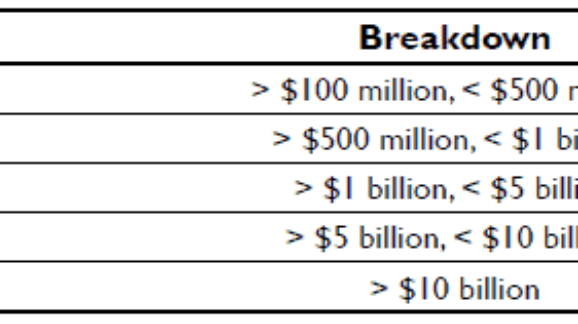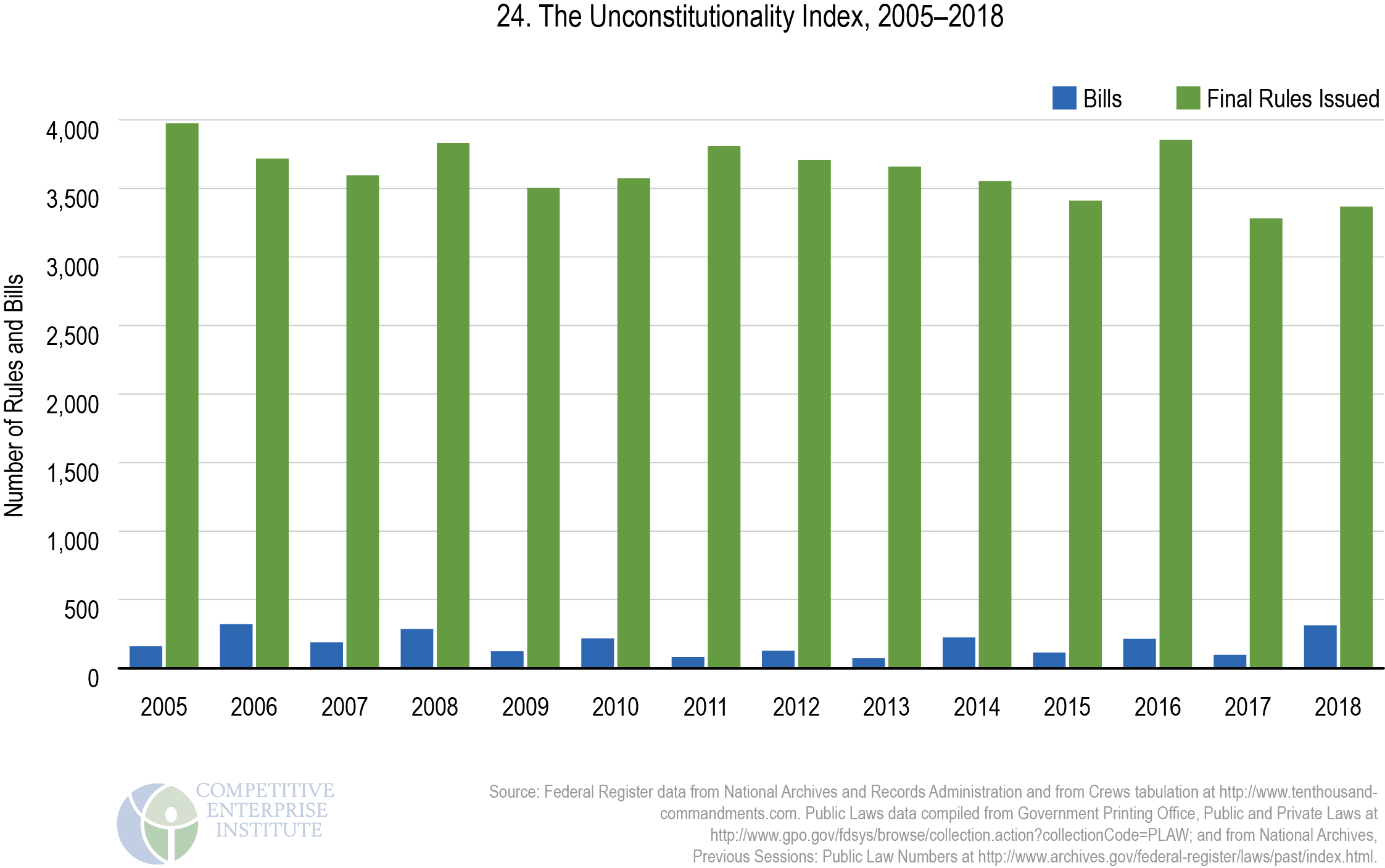Liberate to Stimulate
Ten Thousand Commandments 2019 - Chapter 11

Download Chapter 11 as a PDF
Policy makers frequently propose spending stimulus as a way to grow economies. It rarely goes well. A regulatory liberalization stimulus, on the other hand, can offer confidence and certainty for businesses and entrepreneurs. While congressional action is needed, the executive branch can take further steps to continue to stress regulatory streamlining and further specific actions such as requiring rules and guidance to be submitted to Congress and the GAO as intended by the Congressional Review Act. In addition, President Trump should issue new executive orders (a) requiring review of independent agency rules, (b) outlining principles for guidance document preparation and disclosure, and (c) calling for the completion of the aggregate regulatory cost estimate already required by law.
Steps to Improve Regulatory Disclosure
Certainly, some regulations’ benefits exceed costs under the parameters of guidance to agencies such as OMB Circular A-4,[i] but net benefits or even actual costs are not subject to quantification for the most part. Without more thorough regulatory accounting than we get today, backed up by congressional certification of what agencies specifically do, it is difficult to know whether society wins or loses as a result of rules.[ii] Pertinent, relevant, and readily available regulatory data should be summarized and reported publicly to help nurture the political climate for better disclosure and reform. One incremental but important step toward greater openness would be for Congress to require—or for the administration or OMB to initiate—publication of a summary of available but scattered data. Such a regulatory transparency report card could resemble some of the presentation in Ten Thousand Commandments.
Accountability is even more important than disclosure. Congress routinely delegates legislative power to unelected agency personnel. Reining in off-budget regulatory costs can occur only when elected representatives assume responsibility and end “regulation without representation.” Changes made by comprehensive regulatory reform, such as the Regulatory Accountability Act, could help induce Congress to internalize pressures that would inspire cost-benefit appraisals before issuing open-ended directives to agencies to write rules.[iii] More stringent limitations on delegation, such as requiring congressional approval of rules, are essential.
Regulations fall into two broad classes: (a) those that are economically significant or major (with effects exceeding $100 million annually) and (b) those that are not. Agencies typically emphasize reporting of economically significant or major rules, which OMB also tends to highlight in its annual regulatory reports. A problem with this approach is that many rules that technically come in below that threshold can still be very significant in real-world terms.
Moreover, agencies need not specify whether any or all of their economically significant or major rules cost just above the $100 million threshold or far above it. One helpful reform would be for Congress to require agencies to break up their cost categories into tiers, as depicted in Table 11. Agencies could classify their rules on the basis of either (a) cost information that has been provided in the regulatory impact analyses that accompany some economically significant rules or (b) separate internal or external estimates.
Table 11. A Possible Breakdown of Economically Significant Rules
Further, much of the available regulatory information is difficult to compile or interpret. To learn about regulatory trends and acquire information on rules, interested citizens once needed to comb through the Agenda’s 1,000-plus pages of small, multicolumn print, and today compile results from online searches and agencies’ regulatory plans and sites like Regulations.gov. That is all well and good, but data from the Unified Agenda could be made more accessible and user-friendly if elements of it were officially summarized in charts and presented as a section in the federal budget, in the Agenda itself, or in the Economic Report of the President. Suggested components of this regulatory transparency report card appear in Box 6.[i] In addition to revealing burdens, impacts, and trends, it would reveal more clearly what we do not know about the regulatory state, such as, for example, the percentage of rules that failed to quantify costs, and the percentage of rules that failed to quantify benefits.
Furthermore, the accumulation of regulatory guidance documents, memoranda, and other “regulatory dark matter” to implement policy calls for greater disclosure of these kinds of agency issuances than exists now, since these can be regulatory in effect but are nowhere to be found in the Unified Agenda. Inventorying such “dark matter” is difficult to do, but not impossible. Legislation such as the Guidance out of Darkness (GOOD) Act would help remedy the disclosure problem.
In addition, we have little ability to distinguish between additive and subtractive rules and little guidance in terms of burdens imposed. Future regulatory reforms by Congress should require regulatory and deregulatory actions to be classified separately in the Federal Register and for agencies’ overly confusing rule classifications to be harmonized.[ii] Current reporting also distinguishes poorly between rules and guidance affecting the private sector and those affecting internal governmental operations.
Box 6. Regulatory Transparency Report Card, Recommended Official Summary Data
by Program, Agency, and Grand Total, with Five-Year Historical Tables
Given a basic framework, additional information could be incorporated into the report as warranted—for instance, success or failure of special initiatives such as executive branch restructuring or specific regulatory reform efforts. Providing historical tables would prove useful to scholars, third-party researchers, members of Congress, and the public. By making agency activity more explicit, a regulatory transparency report card would help ensure that policy makers take the growth of the regulatory state seriously.
Ending Regulation without Representation: The “Unconstitutionality Index”—11 Rules for Every Law
Regulatory agencies do not answer to voters. Yet in a sense, regulators, rather than Congress, do the bulk of U.S. lawmaking. Legal scholar Phillip Hamburger has described the rise of a monarchical administrative state in defiance of a Constitution that “expressly bars the delegation of legislative power.”[i] But agencies are not the sole offenders. For too long, Congress has shirked its constitutional duty to make the tough calls. Instead, it routinely delegates substantial lawmaking power to agencies and then fails to ensure that they deliver benefits that exceed costs.
The primary measure of an agency’s productivity—other than growth in its budget and number of employees—is the body of regulation it produces.[ii] Agencies face significant incentives to expand their turf by regulating even without established need. It is hard to blame agencies for carrying out the very regulating they were set up to do in the first place. Better to point a finger at Congress.
The “Unconstitutionality Index”—the ratio of rules issued by agencies relative to laws passed by Congress and signed by the president—underscores the triumph of the administrative state over the Constitution. There were 11 rules for every law in 2018 (see Figure 24). In calendar year 2018 regulatory agencies issued 3,368 final rules, while the 115th Congress passed and President Trump signed into law 313 bills.[iii] While Trump’s rule count was lower, the number of laws enacted was higher than in recent years. The average over the past decade has been 28 rules for every law. Rules issued by agencies are not usually substantively related to the current year’s laws; typically, agencies administer earlier legislation. If agency public notices and executive orders are considered, non-legislative policy making assumes even greater prominence as an issue of concern. (Appendix: Historical Tables, Part I, depicts the “Unconstitutionality Index” dating back to 1993 and shows the numbers of executive orders and the numbers of agency notices, which one might arguably incorporate into the Index if so inclined.)

Growing debt and deficits can incentivize Congress to regulate rather than to increase government spending to accomplish policy ends. If Congress wanted to boost job training, funding a program to do so would require legislative approval of a new appropriation for the Department of Labor, which would appear in the federal budget and increase the deficit. Instead, Washington could try to induce Fortune 500 companies to implement job training programs, to be carried out according to new regulations issued by the Department of Labor. The latter option would add little to federal spending but would still let Congress take credit for the program. By regulating instead of spending, government can expand almost indefinitely without explicitly taxing anybody one extra penny.
An annual regulatory transparency report card is needed, but not the complete response. Regulatory reforms that rely on agencies policing themselves within the limited restraints of the Administrative Procedure Act will not rein in the regulatory state or address regulation without representation. Rather, Congress should vote on agencies’ final rules before such rules become binding on the public. Affirmation of new major and controversial regulations would ensure that Congress bears direct responsibility for every dollar of new regulatory costs.
The Regulations from the Executive in Need of Scrutiny Act (REINS) Act offers one such approach.[i] REINS would require Congress to vote on all economically significant agency regulations. It has passed the House in the 115th and the three prior congressional sessions but has not moved forward in the Senate. To avoid getting bogged down in approving myriad agency rules, Congress could vote on agency regulations in bundles. Another way to expedite the process is via congressional approval or disapproval of new regulations by voice vote rather than by tabulated roll-call vote. What matters most is that Members of Congress go on record for whatever laws the public must heed.
If Congress does not act, states could take the ball from Congress. Many state legislators have indicated support for the Regulation Freedom Amendment, which reads, in its entirety: “Whenever one quarter of the members of the U.S. House or the U.S. Senate transmit to the president their written declaration of opposition to a proposed federal regulation, it shall require a majority vote of the House and Senate to adopt that regulation.”[ii] Pressures from states could prompt Congress to decide to act before matters deteriorate that far, but the Constitution does provide for states to check federal power.
While there are possible approaches to boosting disclosure, transparency, and accountability, congressional—rather than agency—approval of regulatory laws and their costs should be the main goal of reform. When Congress ensures transparency and disclosure and finally assumes responsibility for the growth of the regulatory state, the resulting system will be one that is fairer and more accountable to voters.
These safeguards are necessary but not sufficient. Legislative regulatory reform and executive branch streamlining are elements of more fundamental debates. Congress is responsible for the fiscal budget, yet deficits are the norm. The larger questions at hand are over the role and legitimacy of the administrative state and the role of government in a constitutional republic.